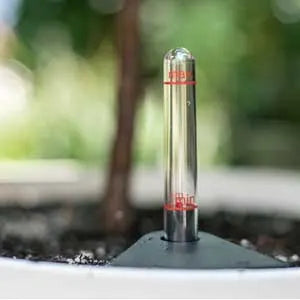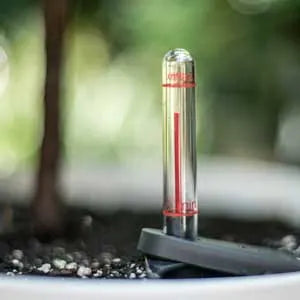Dracaena Tarzan Care
Placement
PRO TIP: If the tips of your Dracaena are brown, you don’t need to cut the whole leaf off. Instead, you can trim off the brown material at an angle. Prune a ‘V’ shape, mirroring the organic shape of the leaves, and your Dracaena will look good as new.
The Dracaena Tarzan is a cultivar of Dracaena Marginata, or the Madagascar Dragon Tree. Discovered by chance just over a decade ago in South Florida, the Dracaena Tarzan has thicker leaves and a thicker trunk than its genetic predecessor, but the same explosive, sword shaped foliage tipped with pink.
Place your Dracaena where it will receive medium to bright indirect light and avoid extended periods of direct sun. It can tolerate the lower end of moderate light spaces but watering will need to be reduced.
If you are unsure of the lighting conditions in your home or office, we also have a guide for how to measure light in your space.

The Dracaena Tarzan may be known as the "King of the Marginatas," but it's one of the most low maintenance tropical plants.
Routine Maintenance
PRO TIP: Dracaena trees are sensitive to salts, minerals, and chlorine in tap water. Let the water sit for 24 hours in a bucket or your watering can before giving it to the plant. This will allow for some of the unwanted materials to evaporate.
Always be sure to assess your plant’s watering needs upon receiving it. Before giving your plant a drink, it is best to check the moisture level in the soil first to ensure it isn’t moist right beneath the surface. Also, consider aerating the soil of your plant before the initial watering. We compact the soil to avoid shifting during transit, so aerating can help the soil breathe and allow moisture to be released.
Like most Dracaenas, the Tarzan requires periods of dryness between waterings. Allow the top 2”-3” inches of the soil to dry before watering your plant. In the warmer months this may take 10-14 days, and in the winter it could be even longer. You never want the soil to be soggy as this plant can be prone to root rot, however allowing the soil to get bone dry will result in brown tips on the plant's leaves. It’s a delicate balance, but once you fall into a routine, the Dracaena Tarzan will react well to regular waterings. The Dracaena also appreciates a humid environment, and will appreciate being kept away from air vents and drafts, and near a humidifier, pebble tray, or given regular misting.
Rotate your plant periodically to ensure even growth on all sides and dust the leaves often so the plant can photosynthesize efficiently. When dusting the leaves, also take the opportunity to inspect the undersides and keep an eye out for pests.
Remember each plant is a unique living thing and may have varying needs, especially in their individual locations. Pay attention to the condition of your Dracaena Tarzan and its watering needs and you will have a long and happy relationship.
Standard Planter Instructions

There are two types of standard planters offered by Greenery NYC—those with drainage holes, and those without. Within those two categories are an array of sizes and styles to choose from. All these factors play a role in the quantity and frequency of water given to your plant.
Plants purchased in a pot without a drainage hole have been set up with a built in drainage system. A layer of hydro stones (porous, absorbent material made of recycled glass) has been placed beneath the soil to act as a reservoir and retain any excess water that flows through the soil. You will need to be slightly more cautious not to pour too much water into these containers as there is no way for the water to escape. We suggest pouring small amounts of water in bit by bit, until you have reached the desired moisture level in the soil.
For plants with a drainage hole, water until it begins to come out the bottom of the pot and into the catch tray.
Always be sure to assess your plant's watering needs upon receiving it. Refer to the routine maintenance section for moisture requirements. Dracaena Tarzan typically require 3 - 5 standard measuring cups of water for the initial watering.
Self Watering Container Instructions

The self-watering planters require a good, solid watering of the topsoil after they are first placed. This is important, because the roots of the plants need to grow into the reservoir in order to drink from it. Follow the standard planter instructions for the first four weeks until the reservoir is ready to be tested.
TEST: After four weeks, fill the reservoir until the red indicator reaches the MAX line. If the indicator goes down over the first few days, it means the plant is ready for reservoir servicing. If not, be sure to continue top watering for a few more weeks, until the plant starts drinking from the reservoir.
RESERVOIR SERVICING: Once the indicator goes down, do not refill the reservoir right away. Similar to how humans need a breath of air between gulps of water, almost all plants require a drying out period. Dracaena Tarzan need to dry out between waterings, so once the reservoir is empty wait a few days before you refill. Always allow for the reservoir to empty all the way, and after the drying out period, be sure to fill it until the indicator reaches the MAX line.
From here on out, you should NEVER topwater the plant. If you water from the top, it can drown the plant. In the Self Watering Container, the top layer of soil will eventually become extremely dry and hard, and may even pull away from the edges of the pot. This is not a cause for concern, but simply because the plant is drinking directly from its roots in the water reservoir.

Step 1: Top water for two weeks. The indicator will look empty, like the picture above.

Step 2: Fill the reservoir until the red indicator reaches the MAX line.

Step 3: Watch the indicator over the next day or two. If it goes down on its own, it means the roots of the plant have grown into the reservoir. From here on out, ONLY water in the reservoir.
Frequently Asked Questions
Help! The leaves of my new Dracaena are turning yellow.
- All plants go through an adjustment period when settling into a new space. Dracaenas in particular are very sensitive to transplant shock. Your new Dracaena may lose a few leaves when it first enters your space, but this is normal behavior that will subside in a couple of weeks once the plant gets comfortable with its new surroundings.
Why are the leaves on my Dracaena turning brown?
- The most common reasons are under or overwatering. Dracaena Tarzans do not like the soil to dry out completely, however the soil should never be soggy either. Aim to keep it the moistness of a well wrung out sponge. If the leaves have brown tips or yellow edges, it could be from dry or cold air.
Why are there brown spots developing on the leaves?
- Leaf spotting can happen for many different reasons. However, Dracaenas in particular are sensitive to fluoride in the water, and can accumulate it in their systems over time. If your Dracaena exhibits these symptoms, leave your water out overnight before you administer it to the plant. Many of the chemicals in the water, including fluoride, will evaporate when exposed to air.
Why are the tips of my Dracaenas’ leaves turning yellow or brown?
- Some “tipping” is normal with this plant variety. However if more than a few leaves seem affected, or the tips are sizable, then it is likely an issue with watering.
How can I tell if I overwatered or underwatered my Dracaena Tarzan?
- If your tree is showing brown tips with yellow edging then you are likely overwatering. If you see fully yellow leaves, and some crispy brown tips without yellow edging then it is likely due to underwatering. Always feel the soil to see if its conditions match your diagnosis, and consider the recent care you have given.
How often should I fertilize my plant?
- In general, house plants will thrive when they are fertilized spring through fall. Fertilize once a month with an organic houseplant fertilizer, following the package instructions for dilution and administration. Greenery NYC uses an organic potting mix with a slow release fertilizer in the soil, so your plant will not need fertilizer within the first 6 months of receiving it.
How often does my plant need to be repotted?
- For larger floor plants, we suggest repotting every 18-24 months. Typically you want to choose a potting vessel 2”- 4” larger in diameter to allow for growth. Don’t choose a pot much larger than the previous as this could drown the plants roots. If you prefer to maintain the current size of your plant, repot into the same vessel, providing new soil and trimming away some roots and foliage. Spring or summer is the ideal time to repot as the plant is at its strongest.
Additional Care Guides
email signup
Get the first look at new products, collaborations, events, sales and more


